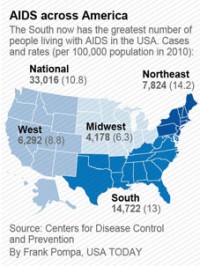CLICK HERE to read original article on USAToday.com
WASHINGTON, D.C. – There are no scientific reasons the world can’t chart a path, albeit a difficult one, toward the world’s first AIDS-free generation, a top federal health official said Sunday.
“There is no excuse scientifically to say we cannot do it,” said Anthony Fauci, director of the National Institute of Allergy and Infectious Diseases, speaking to the media at AIDS 2012, an international AIDS conference, which began here Sunday. “What we need now is the political and organizational will to implement what science has given us.”
The challenges of the AIDS pandemic are great, Fauci said. Worldwide, the disease has claimed more than 30 million lives, and 34 million people today are infected withHIV, the virus that causes the disease. About 2.5 million people worldwide still die each year, Fauci said.
Yet scientists are talking enthusiastically about recent discoveries that, when combined, have the potential to dramatically curtail new infections. Last week, leading researchers called for a new push to cure the disease. In another landmark finding that Fauci described as a “slam-dunk, out of the ballpark,” researchers last year showed that getting an HIV-positive patient’s virus under control makes that person virtually non-contagious.
That suggests that getting proper treatment to more people with HIV — 20% of whom don’t know they are infected — could be a powerful tool to stop the spread of the disease, Fauci said. Most new infections are spread by people who do not realize they have the disease, he said.
Turning the tide “is not going to happen spontaneously,” Fauci said. “It’s going to require purpose and commitment.”
Bill Gates, co-founder of the Bill & Melinda Gates Foundation, a major funder of AIDS research, is more skeptical. “We don’t have the tools” to end the AIDS pandemic today, Gates said at the conference Monday. While he’s impressed with research toward a vaccine, he said the best prevention strategy available today is voluntary, medical male circumcision, which can reduce a man’s risk of infection by 60%.
His foundation also has funded research into microbicide gels for women to use before sex. And he said he was enthusiastic about microbicidal rings, which could potentially provide long-lasting protection.
A mantra among AIDS advocates now is “seek, test, treat and retain,” said Nora Volkow, director of the National Institute on Drug Abuse. Public health officials want to test undiagnosed patients for HIV, treat their disease and retain them in care.
And while those challenges are daunting, Fauci noted that the USA has always led in the fight against AIDS. The National Institutes of Health has spent $50 billion on AIDS since 1982.
And the USA has succeeded in other difficult circumstances before — such as providing AIDS drugs to Africa. Fauci noted that “naysayers” were doubtful about PEPFAR, the President’s Emergency Plan for AIDS Relief, a $15 billion effort launched in 2003 byGeorge W. Bush, after consultation from Fauci.
At that time, only 50,000 people in the developing world had access to anti-retroviral therapy, the drug cocktails credited with transforming AIDS from a death sentence into a chronic disease. Since then, PEPFAR — which received an additional $48 billion in funding in 2008 — has provided AIDS therapy to nearly 4 million people. The program also is credited with preventing HIV infection in 200,000 babies by providing drugs to 660,000 HIV-infected mothers.
PEPFAR must be reauthorized by Congress next year. And while many are focused on cutting the federal budget, Fauci said PEPFAR has always had support from both Republicans and Democrats. “I can’t imagine not authorizing an overwhelming success,” Fauci said.

